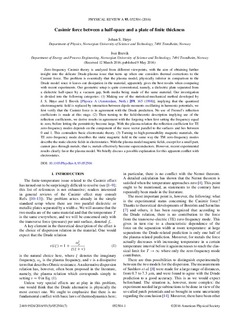| dc.contributor.author | Høye, Johan Skule | |
| dc.contributor.author | Brevik, Iver Håkon | |
| dc.date.accessioned | 2017-12-19T11:32:41Z | |
| dc.date.available | 2017-12-19T11:32:41Z | |
| dc.date.created | 2016-05-10T10:53:16Z | |
| dc.date.issued | 2016 | |
| dc.identifier.citation | Physical Review A. Atomic, Molecular, and Optical Physics. 2016, 93 (5), . | nb_NO |
| dc.identifier.issn | 1050-2947 | |
| dc.identifier.uri | http://hdl.handle.net/11250/2472814 | |
| dc.description.abstract | Zero-frequency Casimir theory is analyzed from different viewpoints, with the aim of obtaining further insight into the delicate Drude-plasma issue that turns up when one considers thermal corrections to the Casimir force. The problem is essentially that the plasma model, physically inferior in comparison to the Drude model since it leaves out dissipation in the material, apparently gives the best results when comparing with recent experiments. Our geometric setup is quite conventional, namely, a dielectric plate separated from a dielectric half-space by a vacuum gap, both media being made of the same material. Our investigation is divided into the following categories: (1) Making use of the statistical-mechanical method developed by J. S. Høye and I. Brevik [Physica A (Amsterdam, Neth.) 259, 165 (1998)], implying that the quantized electromagnetic field is replaced by interaction between dipole moments oscillating in harmonic potentials, we first verify that the Casimir force is in agreement with the Drude prediction. No use of Fresnel's reflection coefficients is made at this stage. (2) Then turning to the field-theoretic description implying use of the reflection coefficients, we derive results in agreement with the forgoing when first setting the frequency equal to zero, before letting the permittivity become large. With the plasma relation the reflection coefficient for TE zero-frequency modes depends on the component of the wave vector parallel to the surfaces and lies between 0 and 1. This contradicts basic electrostatic theory. (3) Turning to high-permeability magnetic materials, the TE zero-frequency mode describes the static magnetic field in the same way the TM zero-frequency modes describe the static electric fields in electrostatics. With the plasma model magnetic fields, except for a small part, cannot pass through metals; that is, metals effectively become superconductors. However, recent experimental results clearly favor the plasma model. We briefly discuss a possible explanation for this apparent conflict with electrostatics. | nb_NO |
| dc.language.iso | eng | nb_NO |
| dc.publisher | American Physical Society | nb_NO |
| dc.title | Casimir force between a half-space and a plate of finite thickness | nb_NO |
| dc.type | Journal article | nb_NO |
| dc.type | Peer reviewed | nb_NO |
| dc.description.version | publishedVersion | nb_NO |
| dc.source.pagenumber | 7 | nb_NO |
| dc.source.volume | 93 | nb_NO |
| dc.source.journal | Physical Review A. Atomic, Molecular, and Optical Physics | nb_NO |
| dc.source.issue | 5 | nb_NO |
| dc.identifier.doi | 10.1103/PhysRevA.93.052504 | |
| dc.identifier.cristin | 1354745 | |
| dc.relation.project | Norges forskningsråd: 250346 | nb_NO |
| dc.description.localcode | © 2016 American Physical Society | nb_NO |
| cristin.unitcode | 194,66,20,0 | |
| cristin.unitcode | 194,64,25,0 | |
| cristin.unitname | Institutt for fysikk | |
| cristin.unitname | Institutt for energi- og prosessteknikk | |
| cristin.ispublished | true | |
| cristin.fulltext | postprint | |
| cristin.qualitycode | 2 | |
